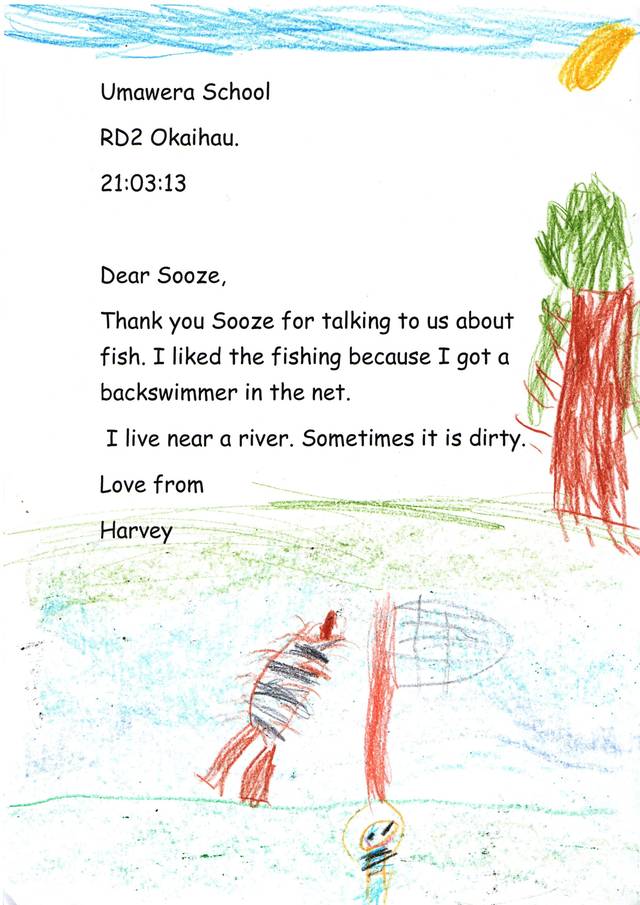 All 31 Umawera School students took part in the WBC programme in Term One, 2013 with coordinator Soozee McIntyre thanks to funding from the ASB Community Trust.
All 31 Umawera School students took part in the WBC programme in Term One, 2013 with coordinator Soozee McIntyre thanks to funding from the ASB Community Trust.
Students learnt about freshwater biodiversity in the classroom and carefully planned a field trip to answer their burning questions, before venturing out to investigate an un-named tributary of the Orira River. The Orira River flows from the Omahuta Forest catchment. Not far from where they carried out the stream investigation, the Orira River drains into the West Coast's Hokianga Harbour via an estuary where the fresh river water meets the salty sea water. The students learnt how this mixed salty and fresh water of the estuary Is called ‘brackish’ water and is an important spawning area for Inanga (one of the species in the 'Whitebait catch').
The students accessed the farm via Mr Oliver’s farm - thanks Mr Oliver! Soozee had set some fish traps overnight. In the first trap there was only one eel and some backswimmers that were moving about rapidly to keep away from the eel! The eel wasted no time in wriggling out of the bucket and heading back towards the water over the grass! Fortunately it got away unharmed as eels are able to ‘breath’ out of water for a while and can easily move over the ground if it is wet. They have a very good sense of smell and can detect where the water is by smelling it. The next traps had lots of fish in them. Most of the fish were juvenile whitebait species, plus some redfin bullies and common bullies. One trap set in a deep pond contained lots of whitebait species like banded kokopu and inanga.
After emptying the traps and identifying the critters in them, the students measured the temperature of the water. It was 15 degrees Celsius, which is nice and cool and healthy for the fish and invertebrates of the stream. They also checked the clarity, with the different groups recording measurements mostly between 55 and 75 centimetres. As 70 cm is a good clarity rating this stream is quite good – especially as it had been raining through the night and that would have made the water a bit muddier.
They measured the pH as well and found it was 6.5, which is what you would expect for a stream coming out of the bush, i.e. only slightly acidic and quite healthy for the stream life. Their next task was to take the scoop nets and see what critters they could find for themselves. After identifying and recording all the critters they caught they released them carefully back into the stream.
You can check out the picture story from their field trip here
Mr Oliver is now planning to fence and plant an ox-bow section of the stream and the students are working with him to help - nice work Umawera! Students will continue to communicate with Mr Oliver (with Natalie Glover providing planning and liaison support) as he finalises the plans to fence. When this is achieved, the students will help to plant riparian species to help stabilise the banks and provide shade for the aquatic life.
Many of the children reported that they looked at other streams near their homes as a result of the programme and talked with their families about the critters they found there and threats they perceived from erosion and stock access.
Principal Christine Gilmour plans to incorporate further freshwater learning by revisiting the stream each season with the students so they can continue monitoring the stream health.
Teachers remarked on the detail of the programme and the motivation it inspired in the children to care for the fresh water environment. Feedback from the students included Marika’s statement, “To help keep the creek as healthy as it already is and cleaner, I think it would be a good idea to keep the cows out of it.” Others said how much they enjoyed being ‘little scientists’ and learning about new critters as well as observing some they were already familiar with. Many remarked on the care they took to return the critters unharmed back to the waterway “so that the stream will stay healthy”.
Check out this awesome student work...


